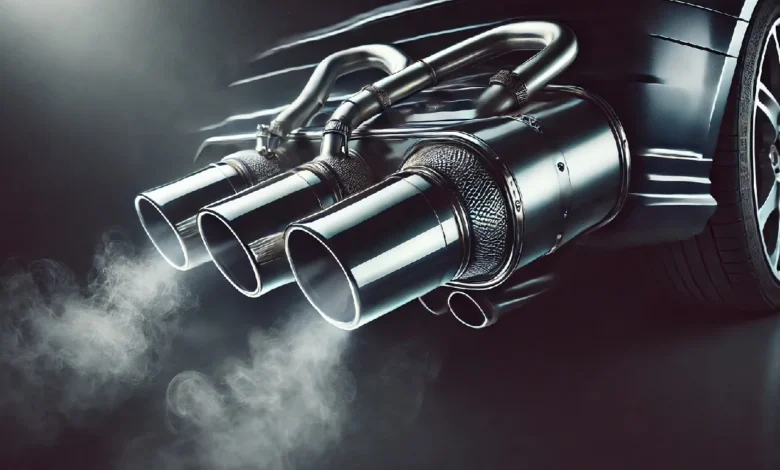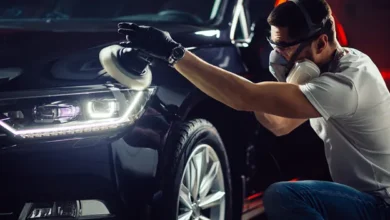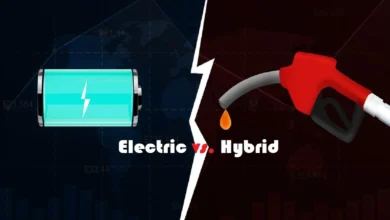
For sound enthusiasts, the exhaust note of a vehicle is one of its most defining characteristics. It’s not just about getting from point A to point B; it’s about the journey, the feeling, and most importantly, the sound that accompanies it. While many car enthusiasts focus on horsepower and torque, for sound lovers, it’s the roar of the engine and the deep rumble of a well-designed exhaust system that truly defines the driving experience.
Upgrading to a high-performance exhaust system is one of the best ways to achieve a custom sound tailored to your preferences while also improving your car’s overall performance. This guide will explore the essentials of high-performance exhaust systems, their benefits, the various types available, and the science behind how exhaust upgrades can transform your vehicle’s sound and power. Whether you’re looking for a more aggressive exhaust note or a refined rumble, this article will provide the insights you need to choose the perfect system.
1. The Fundamentals of a High-Performance Exhaust System
What Makes an Exhaust High-Performance?
A high-performance exhaust system is designed to improve both sound and engine efficiency. Unlike the standard exhaust systems installed in most factory vehicles, performance exhausts are engineered for better airflow and reduced backpressure, allowing the engine to breathe more freely. This results in increased horsepower, torque, and of course, a more robust exhaust note.
The key components of a high-performance exhaust system include:
- Headers: The part of the exhaust system connected to the engine’s cylinder head, designed to optimize the flow of exhaust gases.
- Mufflers: These control the sound of the exhaust by reducing noise levels while maintaining the desired tone.
- Pipes: These transport the exhaust gases from the engine to the tailpipe. Performance exhaust pipes are often wider in diameter to increase airflow.
Sound vs. Performance: A Balancing Act
The main goal for many enthusiasts is improving the car’s sound, but performance also plays a vital role. High-performance exhaust systems are designed to reduce backpressure, which can hinder engine performance. By increasing the efficiency of exhaust gas removal, the engine can generate more power.
The design of the exhaust system, including factors such as pipe diameter, muffler design, and the use of resonators, directly influences both sound quality and engine performance. Enthusiasts often seek a balance between performance gains and achieving the perfect exhaust note—one that’s loud enough to turn heads but not overly obnoxious.
Key Terms for Sound Enthusiasts
To fully appreciate the intricacies of exhaust systems, it’s essential to understand the language surrounding exhaust sounds:
- Growl: A low, deep sound typically heard at lower RPMs, often associated with muscle cars.
- Rumble: A consistent, deep noise that reverberates, popular in V8 engines.
- Drone: An undesirable, constant noise inside the cabin at certain speeds, which can be mitigated with resonators.
- Wail: A high-pitched, aggressive sound often associated with high-revving engines like those in sports cars.
2. Benefits of Upgrading to a High-Performance Exhaust System
Unleashing the Perfect Exhaust Note
One of the primary reasons for upgrading your exhaust system is to improve the sound. Factory exhaust systems are often designed with noise regulations in mind, which can limit the aggressiveness of the exhaust note. High-performance exhaust systems, on the other hand, are engineered for sound enthusiasts. Whether you prefer the deep, thunderous roar of a muscle car or the sharp, crackling pops of a turbocharged engine, the right system can help you achieve the sound that best represents your vehicle’s personality.
Different materials, muffler designs, and pipe configurations contribute to the overall sound profile. For example, larger-diameter pipes and straight-through mufflers allow for a more aggressive sound, while chambered mufflers can create a more controlled, deep rumble.
Increased Power and Torque
While sound is the primary goal for many enthusiasts, performance gains are an added benefit. A high-performance exhaust system reduces the amount of work the engine needs to do to expel exhaust gases, allowing for more efficient combustion. This, in turn, increases horsepower and torque.
For example, replacing a factory-installed exhaust system with a cat-back or header-back system can result in horsepower gains of 5 to 10 percent. The increase in torque also improves acceleration and overall responsiveness, making the car feel more powerful and fun to drive.
Improved Fuel Efficiency
An often-overlooked benefit of exhaust upgrades is improved fuel efficiency. With better airflow, the engine can operate more efficiently, burning fuel more completely. This results in small but noticeable improvements in miles per gallon (MPG). While performance enthusiasts may not prioritize fuel economy, the combination of power gains and better fuel efficiency makes an exhaust upgrade a smart investment.
Customizing Sound to Suit Your Taste
One of the great advantages of high-performance exhaust systems is the ability to customize the sound to your liking. Want a loud, aggressive exhaust note that announces your arrival from blocks away? Choose a straight-through muffler and large-diameter pipes. Prefer a more refined, subtle sound? Opt for a chambered muffler or add a resonator to reduce noise levels without sacrificing performance.
Exhaust tips also play a role in shaping the final sound. Angled tips or rolled edges can further refine the exhaust note, allowing you to personalize your vehicle’s auditory experience.
3. Different Types of High-Performance Exhaust Systems
Cat-Back Systems
A cat-back exhaust system replaces everything from the catalytic converter to the rear of the vehicle. This type of system is one of the most popular upgrades, as it improves both sound and performance without requiring modifications to the engine or catalytic converter.
Cat-back systems typically provide moderate sound improvements and noticeable performance gains, making them ideal for enthusiasts looking for a balanced upgrade.
Axle-Back Systems
An axle-back system replaces the exhaust components located from the rear axle to the exhaust tip. These systems focus more on sound improvement than performance gains, making them perfect for those who want a louder, more aggressive exhaust note without modifying the entire exhaust system.
Since axle-back systems don’t affect engine performance as much as cat-back systems, they are often less expensive and easier to install.
Header-Back Systems
For those seeking maximum performance and sound, a header-back system is the ultimate exhaust upgrade. This system replaces the entire exhaust system from the headers (the part connected to the engine) all the way back to the tailpipes. Header-back systems are ideal for high-performance applications, such as racing or serious track use.
However, due to the complexity of the installation and the significant changes made to the exhaust system, header-back systems are typically more expensive and may require professional installation.
Turbo-Back Systems (For Turbocharged Engines)
For turbocharged engines, a turbo-back system replaces the exhaust components from the turbocharger to the rear of the vehicle. These systems are designed to improve exhaust flow and reduce turbo lag, resulting in quicker throttle response and increased power.
Turbo-back systems are particularly popular among performance enthusiasts with turbocharged vehicles, as they provide both sound and performance improvements tailored specifically to the needs of forced induction engines.
4. Exhaust Materials and Their Impact on Sound
Stainless Steel vs. Mild Steel vs. Titanium
The material used in an exhaust system can greatly affect both performance and sound. Stainless steel is the most common material for high-performance exhaust systems due to its durability and corrosion resistance. It produces a clean, crisp sound and can withstand high temperatures without warping or rusting.
Mild steel is a less expensive alternative but is more prone to rust and corrosion, especially in humid or salty environments. While it can still deliver good sound and performance, its longevity is often a concern.
Titanium, on the other hand, is a premium material used in high-end exhaust systems. It’s incredibly lightweight and offers a unique, exotic sound that’s sharper and more metallic than stainless steel. Titanium exhaust systems are ideal for those who want to reduce weight and achieve a distinctive sound.
Mandrel-Bent vs. Crush-Bent Pipes
The way an exhaust pipe is bent also impacts performance and sound. Mandrel-bent pipes maintain a consistent diameter throughout the bends, ensuring optimal airflow and reducing backpressure. This design is essential for high-performance applications, as it maximizes both power and sound.
Crush-bent pipes, on the other hand, are less expensive but can restrict airflow due to the crushed sections created during the bending process. This can negatively affect both performance and sound quality.
The Role of Pipe Diameter
Pipe diameter plays a significant role in shaping the exhaust sound. Larger-diameter pipes allow for more airflow, resulting in a louder, more aggressive sound. However, it’s important to choose the right diameter for your vehicle’s engine size. Too large a pipe can reduce exhaust gas velocity, leading to a loss of low-end torque.
For most performance applications, a pipe diameter of 2.5 to 3 inches is ideal, depending on the engine’s displacement and power output.
Exhaust Tips
Exhaust tips are the final part of the exhaust system and can also influence sound. Angled tips, rolled edges, and dual outlets can all tweak the exhaust note. For example, larger tips tend to produce a deeper sound, while smaller, more angular tips create a sharper, more aggressive tone.
Exhaust tips are also a cosmetic consideration, allowing enthusiasts to personalize the look of their vehicle’s rear end while enhancing sound quality.
5. How Muffler Design Affects Exhaust Sound
Straight-Through (Glasspack) Mufflers
Straight-through mufflers, also known as glasspacks, are designed for maximum sound and performance. These mufflers feature a perforated tube surrounded by sound-absorbing material, allowing exhaust gases to flow freely with minimal restriction. The result is an aggressive, loud exhaust note with significant performance gains.
While straight-through mufflers are popular for track use, they can be too loud for daily driving, especially in urban areas with strict noise regulations.
Chambered Mufflers
Chambered mufflers use internal chambers and baffles to control the flow of exhaust gases, creating a deep, rumbling sound. These mufflers are ideal for enthusiasts who want a powerful exhaust note without excessive noise. Chambered mufflers are often found on muscle cars, where a throaty, low-end rumble is desired.
Turbo Mufflers
Turbo mufflers combine elements of both straight-through and chambered designs, offering a balance between performance and sound control. These mufflers are great for daily drivers who want improved performance and a louder exhaust note without sacrificing comfort or quietness at highway speeds.
Resonators
Resonators are often added to exhaust systems to reduce unwanted drone at specific RPM ranges. Drone can be particularly annoying during long highway drives, where a constant hum or buzz inside the cabin can become tiresome.
By adding a resonator, you can fine-tune the exhaust sound and reduce interior noise levels while maintaining an aggressive exhaust note outside the vehicle.
6. The Installation Process: DIY vs. Professional

DIY Installation Guide for Sound Enthusiasts
For those with mechanical experience, installing an exhaust system can be a rewarding DIY project. Many cat-back and axle-back systems are designed for bolt-on installation, requiring only basic tools such as wrenches, sockets, and a jack to lift the vehicle.
Here’s a step-by-step guide to installing a cat-back system:
- Safety First: Ensure the vehicle is securely lifted on jack stands and that all necessary tools are within reach.
- Remove the Old System: Unbolt the factory exhaust system from the catalytic converter, starting from the rear of the vehicle and working your way forward.
- Install the New System: Attach the new exhaust components, starting with the mid-pipe and working towards the rear. Make sure all connections are tight and aligned.
- Check for Leaks: After installation, start the engine and check for exhaust leaks at the connection points. Adjust as necessary.
- Fine-Tuning: Once installed, you can fine-tune the exhaust system by adjusting hangers and clamps to ensure proper fitment.
When to Call in the Pros
While DIY installation is possible for many systems, more complex setups like header-back or turbo-back systems may require professional installation. These systems often involve more intricate work, such as removing engine components, welding, or rerouting exhaust pipes.
A professional installer will ensure the system is correctly installed and that performance and sound are optimized. Professional installation can also prevent common issues such as leaks or misaligned pipes.
Fine-Tuning After Installation
After installing your new exhaust system, there may be a break-in period where the sound and performance improve as the system settles. Over time, the exhaust note may deepen or become more refined. It’s also important to periodically check for exhaust leaks or loose hangers that could affect both sound and performance.
7. Legal Considerations for Exhaust System Modifications
Noise Regulations
Many regions have strict noise regulations that limit the volume of a vehicle’s exhaust note. It’s important to check local laws before installing a high-performance exhaust system, as excessive noise can result in fines or even vehicle impoundment.
In some areas, sound levels are measured in decibels (dB) and must fall below a certain threshold, usually between 80 and 100 dB. Many performance exhaust systems are designed to stay within these legal limits, but it’s important to choose a system that complies with your region’s regulations.
Emissions Compliance
Another consideration when upgrading your exhaust system is emissions compliance. In most regions, vehicles are required to meet specific emissions standards, and removing or modifying the catalytic converter can make a vehicle non-compliant.
High-flow catalytic converters are a popular option for enthusiasts who want to improve performance while maintaining emissions compliance. These converters allow for better airflow than factory units but still reduce harmful emissions.
Aftermarket Exhaust Warranty Impacts
Installing an aftermarket exhaust system can sometimes affect your vehicle’s warranty. It’s important to check with both the manufacturer of your vehicle and the exhaust system to ensure that any modifications won’t void your warranty. Some manufacturers offer warranty-friendly exhaust systems, while others may require specific installation procedures to maintain coverage.
8. Best Exhaust Brands for High-Performance and Sound
Borla
Borla is known for producing high-quality exhaust systems with aggressive sound profiles and significant performance gains. Their systems are made from stainless steel for durability and are designed for a wide range of vehicles, from trucks to sports cars.
Flowmaster
Flowmaster is a favorite among muscle car enthusiasts for its deep, throaty exhaust notes. Their chambered mufflers provide a classic American V8 sound, perfect for those who want to make their presence known on the road.
MagnaFlow
MagnaFlow offers a balance between performance and sound, with systems designed to improve both exhaust flow and sound quality. Their mufflers are engineered to reduce drone while providing a smooth, powerful exhaust note.
Akrapovič
Akrapovič is a premium exhaust manufacturer known for its use of titanium and carbon fiber. Their systems are lightweight and designed for high-performance vehicles, offering a distinctive, exotic sound that’s sharp and metallic.
Corsa Performance
Corsa Performance is known for its “no-drone” technology, which reduces unwanted cabin noise while delivering an aggressive exhaust note outside the vehicle. Their systems are popular among daily drivers who want performance and sound without sacrificing comfort.
Frequently Asked Questions About Exhaust Upgrades
Will an exhaust upgrade void my car’s warranty?
It depends on the manufacturer and the type of modification. Some exhaust systems are warranty-friendly, while others may require professional installation to maintain coverage.
Can I pass emissions testing with a high-performance exhaust system?
Yes, as long as the catalytic converter is not removed or modified. High-flow catalytic converters are a good option for those looking to improve performance without sacrificing emissions compliance.
How can I reduce drone in my exhaust system?
Adding a resonator can help reduce drone, especially at highway speeds. Some exhaust systems also feature built-in drone reduction technology.
Is a high-performance exhaust worth the cost for daily driving?
For sound enthusiasts, the auditory experience alone can justify the cost. Additionally, the performance gains and potential fuel savings make it a worthwhile investment for many drivers.
What’s the difference between cat-back and axle-back exhaust systems?
A cat-back system replaces everything from the catalytic converter to the rear of the vehicle, while an axle-back system only replaces the components from the rear axle to the exhaust tip.
Elevate Your Driving Experience
Upgrading to a high-performance exhaust system is one of the most rewarding modifications for any automotive enthusiast, especially those who live for the sound of their car. Whether you’re looking to improve performance, customize your vehicle’s sound, or both, the right exhaust system can transform your driving experience.
With the variety of systems, materials, and brands available, there’s an option for every car and every type of driver. From the aggressive roar of a V8 to the sharp crackle of a turbocharged engine, a high-performance exhaust upgrade offers an exciting blend of sound, power, and efficiency.
For sound lovers, the exhaust note is more than just noise—it’s a connection to the car and the road, an expression of personality, and the ultimate driving soundtrack.
We hope you found this article helpful. If you did, be sure to check out our blog for more great content like this.





